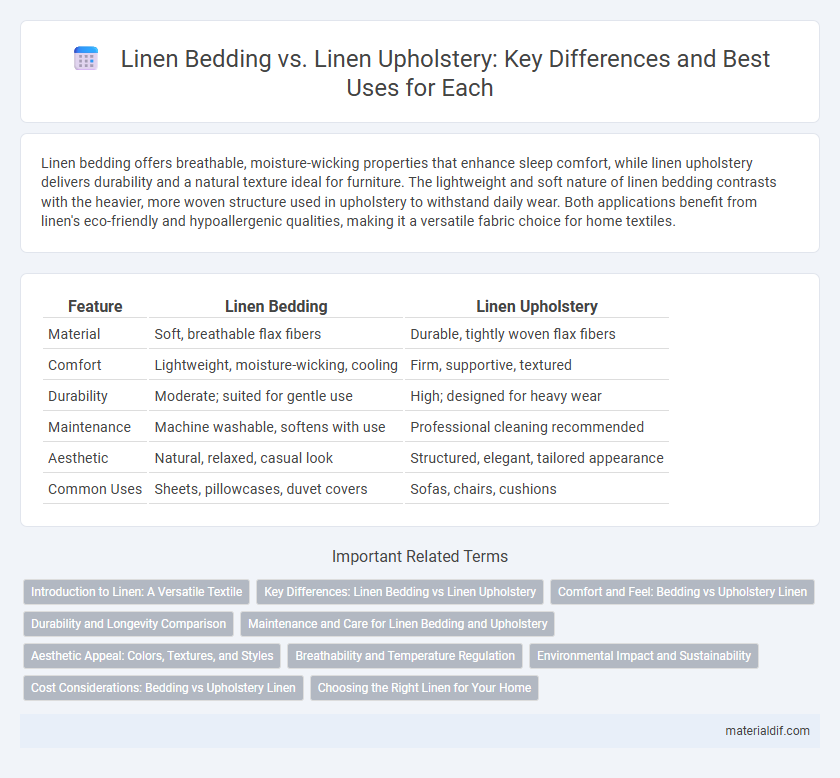Linen bedding offers breathable, moisture-wicking properties that enhance sleep comfort, while linen upholstery delivers durability and a natural texture ideal for furniture. The lightweight and soft nature of linen bedding contrasts with the heavier, more woven structure used in upholstery to withstand daily wear. Both applications benefit from linen's eco-friendly and hypoallergenic qualities, making it a versatile fabric choice for home textiles.
Table of Comparison
| Feature | Linen Bedding | Linen Upholstery |
|---|---|---|
| Material | Soft, breathable flax fibers | Durable, tightly woven flax fibers |
| Comfort | Lightweight, moisture-wicking, cooling | Firm, supportive, textured |
| Durability | Moderate; suited for gentle use | High; designed for heavy wear |
| Maintenance | Machine washable, softens with use | Professional cleaning recommended |
| Aesthetic | Natural, relaxed, casual look | Structured, elegant, tailored appearance |
| Common Uses | Sheets, pillowcases, duvet covers | Sofas, chairs, cushions |
Introduction to Linen: A Versatile Textile
Linen, derived from the flax plant, is renowned for its durability, breathability, and natural texture, making it a preferred textile in both bedding and upholstery. Linen bedding offers exceptional moisture-wicking and temperature regulation, enhancing comfort while promoting a rustic aesthetic. In upholstery, linen provides a sturdy yet elegant fabric choice known for its resistance to wear and timeless appeal in furniture design.
Key Differences: Linen Bedding vs Linen Upholstery
Linen bedding is designed for comfort and breathability, featuring softer weaves that promote moisture-wicking and temperature regulation, essential for a restful sleep environment. Linen upholstery requires a heavier, more durable weave to withstand everyday wear and tear, offering resilience and resistance to stains and fading. Key differences include texture, strength, and fabric treatment, with bedding prioritizing softness and upholstery emphasizing durability and structural integrity.
Comfort and Feel: Bedding vs Upholstery Linen
Linen bedding offers a breathable, soft texture that enhances sleep comfort by regulating body temperature and wicking moisture, making it ideal for night use. In contrast, linen upholstery is treated for durability and resistance to wear, providing a firmer, slightly coarse feel suitable for frequent sitting and aesthetic appeal in living spaces. Both linen types emphasize natural fibers, but bedding prioritizes softness and airflow, while upholstery balances comfort with long-lasting strength.
Durability and Longevity Comparison
Linen bedding typically features a softer weave designed for comfort and breathability, while linen upholstery uses a denser, heavier fabric to withstand daily wear and tear. Upholstery-grade linen offers superior durability due to its thicker yarns and tighter weave, making it resistant to pilling and abrasion over extended use. Both materials benefit from linen's natural strength and moisture-wicking properties, but upholstery linen generally outlasts bedding linen in high-traffic environments.
Maintenance and Care for Linen Bedding and Upholstery
Linen bedding requires gentle washing with mild detergent in cool water to preserve its natural fibers, and air drying is recommended to avoid shrinkage. Linen upholstery demands regular vacuuming and spot cleaning with a mild fabric cleaner to prevent dirt buildup and maintain texture. Both applications benefit from avoiding direct sunlight exposure to prevent fading and fiber weakening.
Aesthetic Appeal: Colors, Textures, and Styles
Linen bedding offers a soft, breathable texture with a natural, muted color palette that enhances bedroom tranquility and complements minimalist or coastal decor styles. Linen upholstery features a denser weave, providing durability while showcasing rich textures and a broader range of hues from earthy neutrals to vibrant tones, suitable for both modern and traditional interiors. The distinct weave and finish in linen upholstery create a structured, elegant appearance, contrasting with the relaxed, casual aesthetic of linen bedding.
Breathability and Temperature Regulation
Linen bedding excels in breathability, allowing air to circulate freely and wick away moisture, which maintains a cool and comfortable sleeping environment. Linen upholstery, while also breathable, is typically woven more densely to withstand wear, resulting in slightly reduced airflow but still better temperature regulation compared to synthetic fabrics. Both applications benefit from linen's natural thermoregulating properties, keeping surfaces cool in summer and warm in winter.
Environmental Impact and Sustainability
Linen bedding typically has a lower environmental impact due to its lightweight, breathable fibers that require less energy for washing and drying compared to linen upholstery, which often involves heavier fabric treatments and additional materials. Flax cultivation for linen production is sustainable, needing minimal water and pesticides, but linen upholstery may involve finishes that reduce biodegradability. Choosing linen for bedding supports sustainability through reduced resource consumption and enhanced durability, while upholstery applications demand careful consideration of chemical treatments that affect environmental friendliness.
Cost Considerations: Bedding vs Upholstery Linen
Linen bedding typically costs less than linen upholstery due to differences in fabric weight and durability requirements, with upholstery-grade linen demanding premium pricing for enhanced strength. Bedding linen uses lighter, softer weaves designed for comfort, reducing material and production expenses compared to the thicker, more robust textiles needed for upholstery. The higher investment in upholstery linen reflects its capacity to withstand wear, stains, and daily friction, making cost a crucial factor when selecting linen for either application.
Choosing the Right Linen for Your Home
Linen bedding offers unparalleled breathability and moisture-wicking properties, making it ideal for maintaining comfort during sleep, while linen upholstery requires a heavier weave for enhanced durability and resistance to wear. Opting for lightweight, finely woven linen fabrics enhances softness and airflow in bedding, whereas tightly woven, thicker linen is better suited to withstand the rigors of daily furniture use. Selecting the appropriate linen type based on fabric weight and weave ensures longevity and functionality tailored to your home's specific needs.
Linen Bedding vs Linen Upholstery Infographic

 materialdif.com
materialdif.com